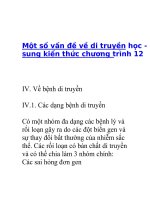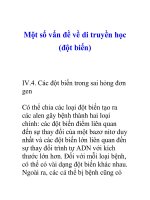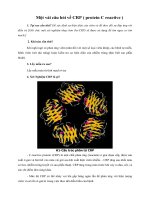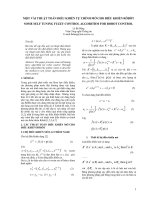Tài liệu Một vài kết quả về hàm chọn. pdf
Bạn đang xem bản rút gọn của tài liệu. Xem và tải ngay bản đầy đủ của tài liệu tại đây (2.77 MB, 5 trang )
T~p chi
Tin tioc
vi
Dieu
khien hgc, T.17, S.l (2001),35-39
SOME RERUl TS ABOUT CHOICE FUNCTIONS
vu Due NGHIA
Abstract. The family of functional dependencies (FDs) is an important concept in the relational database.
The choice function is the equivalent description of the family of FDs. This paper gives some results about
choice functions. Some properties of choice functions, such as comparison between and composition of two
choice functions, are investigated.
Tom tlit. H9 cic phu th uoc him la met khii niern quan trorig trong
CO'
so' dir li~u quan h~. Bai nay
dtra
ra
kh ai niern him chon la mo
t
su: me ti tU'ong
dtro'ng
ciia ho cac phu th uoc him va trlnh bay mot so ket qui
nghien cu'u ve him chon.
1. INTRODUCTION
The relational datamodel which was introduced by E. F. Codd is one of the most powerful
database models. The basic concept of this model is the relation, which is a table that every row of
which corresponds to a record and every column to an attribute. Because the structure of this model
is clear and simple, and mathematical instruments can be applied in it, it becomes the theoretical
basis of database models. Semantic constraints among sets of attributes play very important roles
ill logical and strnctural investigations of relational data model both in practice and design theory.
The most
i
m por
t
a.n
t
among these constraints is the family of FDs. Equivalent descriptions of the
family of FDs h ave been widely studied. Based on the equivalent descriptions, we can obtain many
important properties of the family of FDs. Choice function is one of many equivalent descriptions
of the family of Fils. In this paper we investigate the choice functions. We show some properties of
choice functions, which concerntrate much on the comparison between and composite of two choice
functions.
Let us give some necessary definitions that are used in the next section. The concepts given in
this section can be found in
11-8,11,121.
Definition 1.1.
Let
U
=
{a
1, ,
an}
be a nonempty finite set of attributes. A functional dependency
(FD) is a statement of the form
A
>
B,
where
A, B ~ U.
The FD
A
>
B
holds in a relation
R
=
{hi, ,
hrn}
over
U
if V
hi, h]
E
R
we have
h;(a)
=
h](a)
for all
a
E
A
implies
hi(b)
=
hJ(b)
for
all
b
E
B.
We also say that
R
satisfies the FD
A > B.
Definition 1.2.
Let
Fn
be a family of all FDs that hold in
R.
Then
F = Fn
satisfies
(1) A > A
E
F,
(2) (A
>
B
E
F, B
+
C
E
F)
*
(A
>
C
E
F),
(3) (A >BEF, A;:;C, D~B)*(C >DEF),
(4) (A
>
B
E
F,
C
>
DE
F)
*
(A
u
C
>
BuD
E
Fl·
A family of FDs satisfying (1) - (4) is called an J-family (sometimes it is called the full family)
over
U.
Clearly,
Fn
is an J-family over
U.
It is known
111
that if
F
is an arbitrary i-family, then there
is a relation
Rover U
such that
Fn
=
F.
Given a family
F
of FDs over
U,
there exists a unique minimal i-family
F+
that contains
F.
It
can be seen that
F+
contains all FDs which can be derived from
F
by the rules (1) - (4).
Definition 1.3.
A relation scheme s is a pair
(U, F),
where
U
is a set of attributes, and
F
is a set
36
vu Due NGHIA
of FDs over
U.
Denote
A
+ =
{a : A
->
{a}
E
F+}. A
+
is called the closure of
A
over
s.
It is clear that
A
->
B
E
F+
if
B
S;;;
A+.
Clealy, if
s
=
(U, F)
is a relation scheme, then there is a relation
Rover
U
such that
Fn
=
F+
(see
11]).
Definition
1.4. Let
U
be aq nonempty finite set of attributes and
P(U)
its power set. A map
L : P (U)
->
P (U)
is called a cosure over
U
if it satisfies the following conditions:
(1) A ~ L(A),
(2) A ~ B
implies
L(A)
<
L(B),
(3) L(L(A))
=
L(A).
Let
s
=
(U, F)
be a relation scheme. Set
L(A)
=
{a: A
->
{a}
E
F+},
we can see that
L
is a
closure over
U.
Theorem
1.1.
If F is a f-family and
~j
LdA)
=
{a : a
E
U and A
->
{a}
E
F}, then LF is a
closure. Inversely, if L
tS
a closure, there exists only a f-family F over U such that L
=
L
F
, and
F
=
{A
->
B : A, B ~ U, B ~ L (A) } .
So we can conclude that there is a
1-1
correspondence between closures and f-families on
U.
Definition
1.5. Let
U
be a nonempty finite set of attributes and
P( U)
its power set. A map
G:
P(U)
->
P(U)
is called a choice function, if every
A
E
P(U),
then
G(A) ~ A.
If we assume that
G(A)
=
U - L(U - A)
(*),
we can easily see that G is a choice function.
Theorem
1.2.
The relationship like
(*)
is considered as a
1-1
correspondence between closures and
choice
[unctions,
which satisfies the following two conditions:
For every A, B ~ U,
(1) If G(A.) ~ B
<
A, then G(A)
=
G(B),
(2) If A ~ B, then G(A)
<
G(B).
We call all of choice functions satisfying those two above conditions special choice functions.
From Theorems
1.1
and
1.2,
we have the following important result.
Theorem 1.3.
There is a
1-1
correspondence between special choice
[unctions
and f-families on U.
We define
I'
as a set of all of special choice (SC) functions on
U.
Now we investigate some
properties of those functions.
2. RESULTS
First of all we give the definition of a composite function of two SC functions.
Definition
2.1. Let
f, 9
E I',
and we determine a map
k
as a composite function of
f
and
9
as the
following:
k(X)
=
f(g(X))
=
f.g(X)
=
fg(X)
for every X ~
U.
Definition
2.2. Let
U
be a nonempty set finite set of attributes, and
f, 9
E
f.
We say that
f
is
smaller than
g,
denoted as
f
:S
9
or
g
?:
I,
if for every X ~
U
we always have
f(X) ~ g(X).
The "smaller" relation,
:S,
satisfies these following properties. For every [,
g,
h
E
I':
1)
f
=
f
(Reflexive)'
2) If
f
:S
s,
and
9
:S
i,
then
9 = f
(Symmetric),
3) If
f
:S
g,
and
g:S
h,
then
f
:S
h
(Transitive).
SOME RERULTS ABOUT CHOICE FUNCTIONS
37
Proposition 2.1.
If
I,
9
E
r,
then
(1)
fg
<
f
(2)
fg
<
9
(3)
gf
<
f
(4)
gf
<
g.
Proof.
Since
t,
9
E
I',
f
and
9
must be SC functions on
U.
Therefore, we have
g(X) ~
X for every
X ~
U,
then
f(g(X)) ~ f(X)
(1). And
f
is a SC function on
U,
so
f(g(XX)) ~ g(X)
(2). So we
can conclude that
f
9 <
f
and
f
9 ~
g.
Similarly, we can easily prove (3) and (4).
Proposition 2.2.
If
t,
h,
9
E
r.
and f
<
q,
then
(1)
fh
<
gh
(2)
hf
<
hg.
Proof.
Because
I,
9
and
h
are three SC functions and
f ~ g,
we always have
f(J(X)) ~ g(h(XX),
for
every X ~
U.
Since
f ~ g,
we have
f(X) ~ g(X). h
is a SC function, so we have
h(J(X)) ~ h(g(X)).
We can conclude that
f h ~ gh
and
hf ~ hg.
Proposition 2.3.
If
t,
g, h,
kEf,
and f ~ g, k
<
h,
then fk ~ gh.
Proof.
Assume
f,g,h,k
E
I', and
f ~ g, k ~ h.
According to Proposition 2.2, we have
fk ~ gk
and
gk ~ gh.
Therefore, according to the transitive property, we have
f k ~ gh.
Theorem 2.1.
If
i,
9
E
I",
then these following two
conditions
are equivalence:
(1)
f <
g;
(2)
fg=
t.
Proof.
(1)
=>
(2). Assume
t,
9
E I' and
f ~ g.
Since
f
is a SC function,
f
must satisfies this property:
if
f(X) ~ Y ~
X, then
f(X)
=
f(Y).
Therefore, we have
f
< 9
or
f(X) ~ g(X) ~
X for every
X ~
U,
so
f(g(X))
=
f(X)
or we conclude that
fg
=
f.
(2)
=>
(1). Assume
i.s
E
I' and
fg
=
f.
Since
f
and
9
are SC function, according to Proposition
2.1, we have
fg ~ g,
but
fg
=
i ,
so we have
f ~ g.
The proof is completed.
From Theorem 2.1, we can easily see that if
f ~ g,
then
fg
is a SC function (since
fg
=
i,
and
f
is a SC function).
We also can generalize Theorem 2.1 as the following:
Let
is, ,i.:
be SC functions and
h
=
min{fl' ,
fn}
(That is,
i,
is samllest among
fl' ,
i-:
That means
h ~
fi,
for all z
=
1,
,n).
Then
hfi2fi3'" fin
=
h,
and
{fi2,
[cs, ,
fin}
is a permutation of
{h,
[s, ,
fn}:
This statement can be proved easily by induction method. (Key:
h·fi
=
h
whenever
h ~
fi,
fort=l, ,n).
Lemma 2.1.
If f
E
r,
then f f
=
t .
Proof.
We have
f
E
I', so
f
is a SC function. Besides that, we always have
f
=
i,
so according to
Theorem 2.1, we have
f f =
i
Theorem 2.2.
Let
t,
9
E
f.
A composite function of f and g, denoted as fg, is a
se
function if
and only if fgf
=
f g:
(is
is a
se
function
{o}
fgf
=
fg)
Proof.
First of all we need to prove that
f 9
is a choice function.
38
vu Due NGHIA
For every
X ~ U,
we have
g(X) ~ X
because
g
is a SC function. And
f
also is a SC function,
so if
g(X) ~ X,
then
f(g(XX)) ~ f(X) ~ X.
Therefore, we can conclude that
fg(X) ~ X,
in other
word, we can say that
f
g
is a choice function. similarly, we can prove that
g
f
is also a choice function.
Now, we must prove that
f g
is a SC function
{o}
f g f
=
f g.
First, we need to prove the statement: if
f g
is a SC function, then
f gf
=
f g.
According to
Proposition 2.1, we have
fg::::; f.
And
fg
is a SC function, so
fgf
=
fg
due to Theorem 2.1.
Then, we just need to prove that if
f g f
=
f g,
then
f g
is a SC function. In other words, we need
to prove that if
f gf
=
f g,
then
f g
satisfies these following two conditions:
1) If
X
<
Y,
then
fg(X)
<
fg(Y).
2) If
fg(X)
<
Y ~ X,
then
fg(X)
=
fg(Y).
We prove that 1) is true. When
X ~ Y,
we have
g(X) ~ g(Y)
since
g
is a SC function. And
when
g(X) ~ g(Y),
we have
f(g(X)) ~ f(g(Y))
or
fg(X) ~ fg(Y)
since
f
is also a SC function. So
we can conclude that 1) is true.
After that, we move to prove that 2) is true. We have
fg(X) ~ Y ~ X,
so
g(tg(X)) ~ g(Y) ~
g(X)
or
gfg(X) ~ g(Y) ~ g(X)
since
g
is a SC function. And since
f
is also a SC function, we also
have
f(gfg(X)) ~ f(g(Y)) ~ f(g(X))
or
fgfg(X) ~ fg(Y) ~ fg(X).
We can rewite that expression
as
fgg(X) ~ fg(Y) ~ fg(X).
Therefore,
fg(X)
=
fg(Y).
Consequencely, we can conclude that
f g
is a SC function iff
f gf
=
f g.
The proof is completed.
T'heor ern 2.3.
Let
t.
g
E
r.
Then fg and gf are simultaneously
se
[unctions
if and only if fg
=
gf.
Proof.
In the proof of Theorem 2.2, already we have proved that
f g
and
g f
are always choice functions
when
f
and
g
are SC functions.
Now, we need to prove this statement: if
f
g
and
g
f
are simultaneously SC functions, then
fg
= oi .
for
t,»
E
r.
According to Proposition 2.1, we have
f g ::::;g
and
f g ::::;f.
So due to Proposition 2.3, we have
(tg)(tg) ::::;gf.
But we also have
fg
is a SC function, so
(tg)(tg)
=
fg
due to Lemma 2.1. Thus,
(tg)(tg)
=
fg::::; gf.
Similarly, we also have
gf::::;
is.
Hence, we have
fg::::; gf::::; fg,
so we can
conclude that
f
g
=
g
t.
Then, we just need to prove that: if
fg
=
st .
then
fg
and
gf
are simultaneously SC functions
for
f, g
E
r.
In other words, we need to prove that if
f g
= si ,
then
f g
and
g f
satisfies these following
two conditions:
1) If
X ~ Y,
then
fg(X) ~ fg(Y)
and
gf(X) ~ gf(Y).
2) If
fg(X) ~ Y ~ X,
then
fg(X)
=
fg(Y),
and if
gf(X) ~ Y
<
X,
then
gf(X)
=
gf(Y).
We prove that 1) is true. In the proof of Theorem 2.2, we have already proved 1): if
X ~ Y,
then
fg(X) ~ fg(Y).
Similarly, we also can prove that
gf(X) ~ gf(Y).
After that, we move to prove 2) is true. We have
fg(X) ~ Y ~ X,
so
g(tg(X)) ~ g(Y) ~ g(X)
or
gfg(X) ~ g(Y) ~ g(X)
since
g
is a SC function. And since
f
is also a SC function, we also have
f(gfg(X)) ~ f(g(Y))
<
f(g(X))
or
fgfg(X)
<
fg(Y) ~ fg(X).
We can rewite that expression as
ffgg(X) ~ fg(Y) ~ ffgg(X)
=
fg(X)
<
fg(Y) ~ fg(X).
Therefore,
fg(X)
=
fg(Y).
Similarly, we also prove that if
gf(X) ~ Y ~ X,
then
gf(X)
=
gf(Y).
Consequencely, we can say that
f g
ans
g f
are simultaneously SC functions if and only if
f g
=
g f
for
i,
g
E
r.
The proof is completed.
So far, we have covered some properties of the composition of two SC functions and found out
some very interesting results. At the end of this article, we would like to raise the following two
questions:
1) Can we generalize Theorem 2.2 for the composition of
n
SC functions? And will we get the
same answer? More generally, what is a necessary and sufficient condition such that a composite
function of
n
SC functions is a SC function?
2) Is the union, intersection, or subtraction of two SC functions a SC function?
SOME RERULTS ABOUT CHOICE FUNCTIONS
39
REFERENCES
[1] Armstrong W. W.,
Dependency structures of Database Relaiionsliips,
Information ProceSCing
74, Holland Pub!. Co., 1994,580-583.
[2] Beeri C., Bernstein P. A., Computational problems related to the design of normal form relation
schemes,
ACM Trans. on Database Syst.
4 (1)(1979) 30-59.
[3] Beeri C., Dowd M., Fagin R., Staman R., On the structure of Armstrong relations for functional
dependencies,
J.
ACM31
(1) (1984) 30-46.
[4] Demotrovics
J.,
Katona G. O. H., A survey of some combinatorial results concerning functional
dependencies in database relations,
Anals of Moitiematice and Arficial Intelligence
7 (1993)
63-82.
I
[5] Demetrovics
J.,
Libkin L., Muchnik 1.B., Functional dependencies and the semilattice of closed
classes,
Proceedinqs of MFDBS
87,
Lecture Notes in. Computer Science,
1987, 136-147.
[6] Demetrovics
J.,
Libkin L., Muchnik 1.B., Gusztav Hencsey, Normal form relation schemes: a
new characterization,
Acta Cybernetica Hungary
10
(3) (1992) 141-153.
[7] Demetrovics
J.,
Thi V. D., Some results about functional dependencies,
Acta Cybernetica Hun-
gary
8
(3) (1988) 273-278.
[8]
Demetrovics
J.,
Thi V. D., On algorithms for generating Armstrong relations and inferring func-
tional dependencies in the relational datamodel,
Computers and Mathematics with Applications,
Greate Britain,
26
(4) (1993) 43-55.
[9] Demetrovics
J.,
Thi V. D., Armstrong relation, functional dependencies and strong dependen-
cies,
Computers and AI
14
(3) (1995) 279-298.
[10] Demetrovics
J.,
Thi V. D., Some computational problems related to the functional dependencies
in the relational datamodel,
Acta Scientiarum Mathematicarum
57
(1993) 627-638.
[12] Demetrovics
J.,
Thi V. D., Describing candidate keys by hypergraphs,
Computer and Arficial
Intelligence
18
(2) (1999) 191-207.
Received August 30, 2000
Revised September 10, 2000
Umversity of Buffalo









